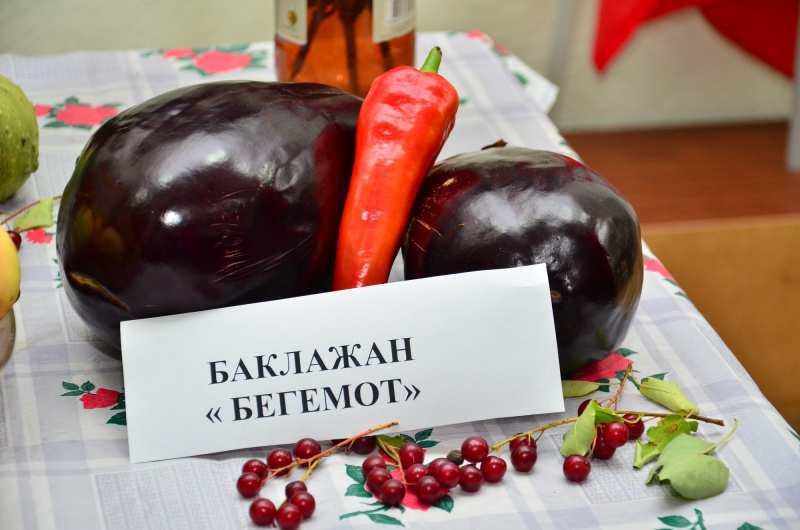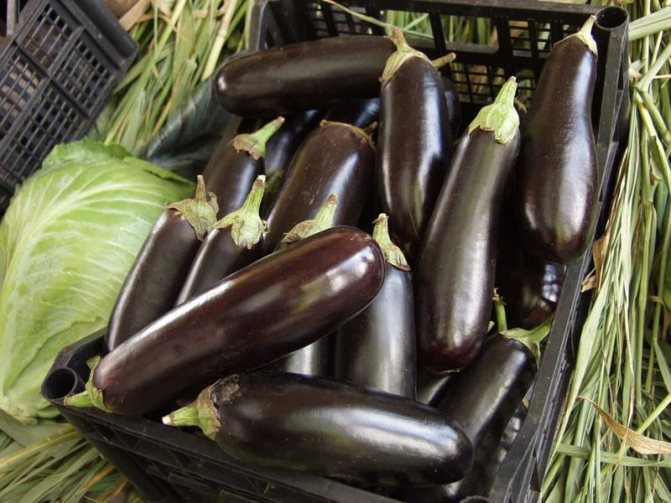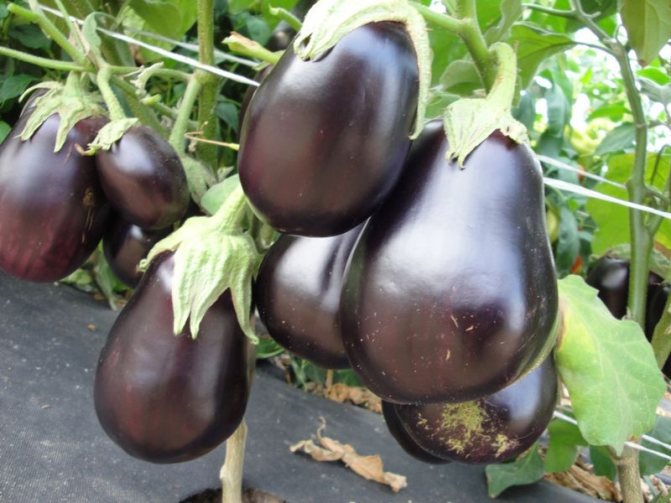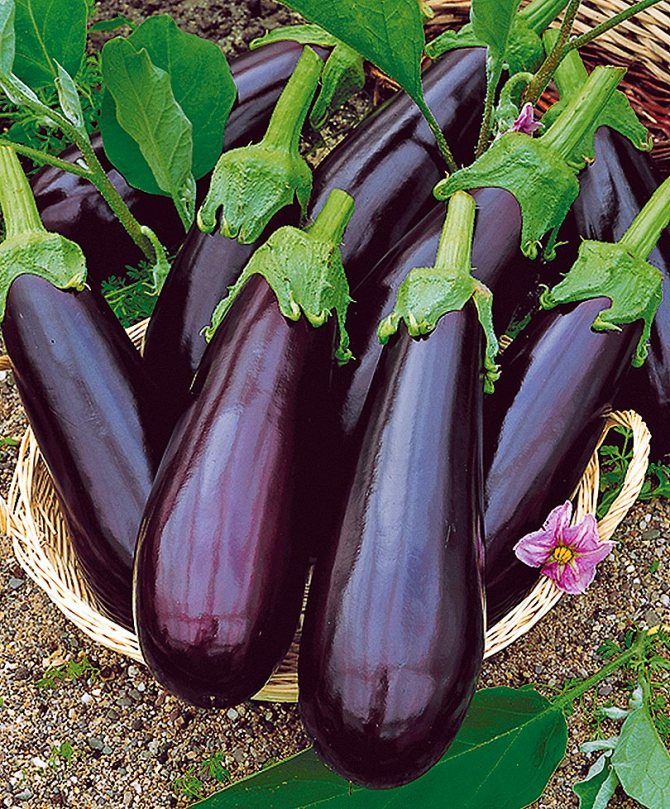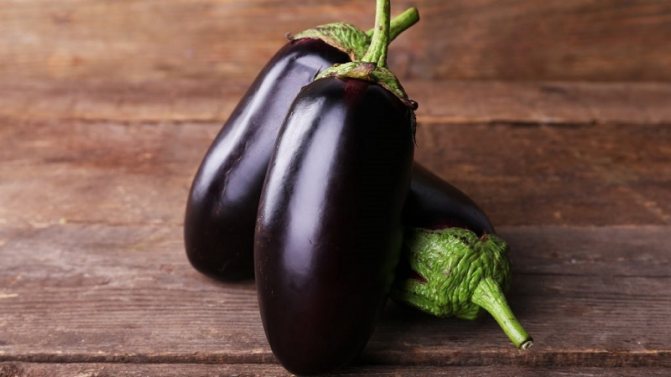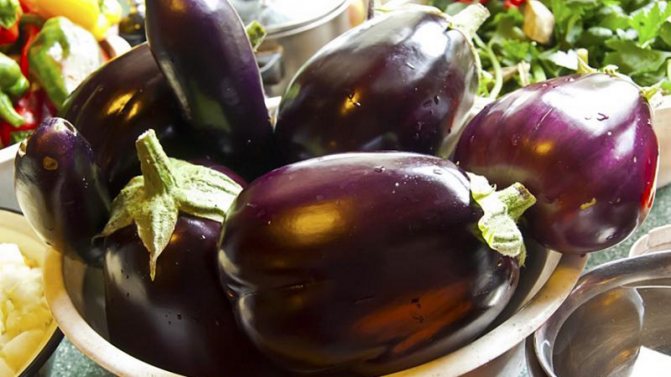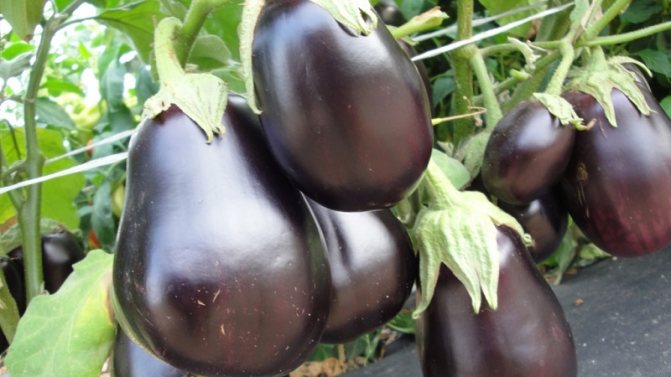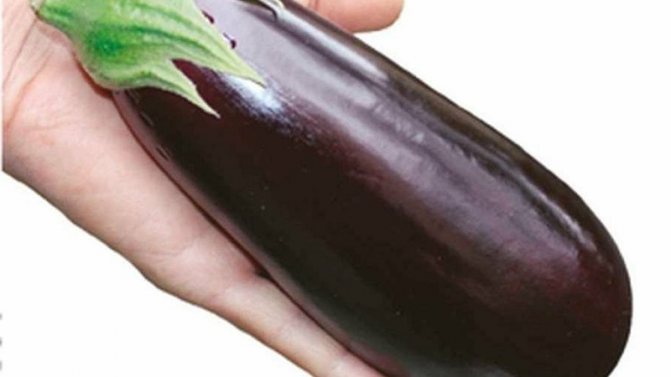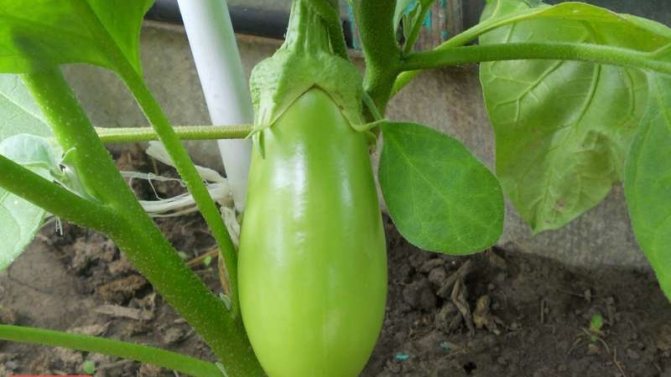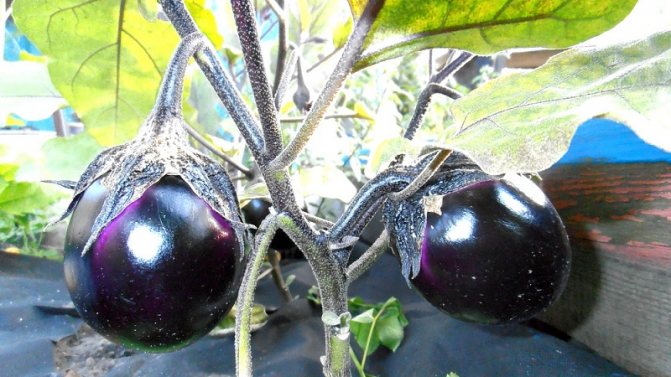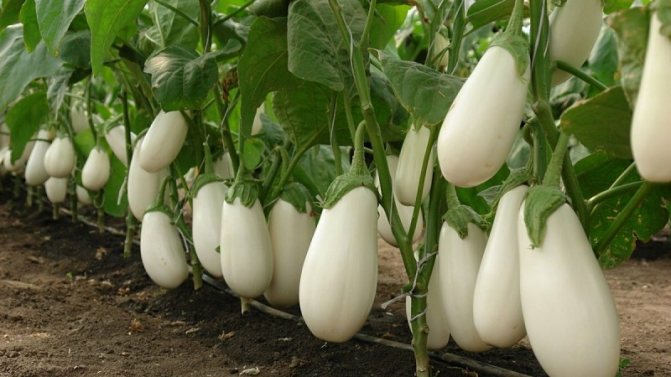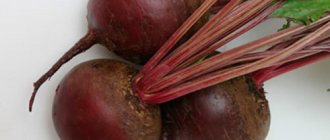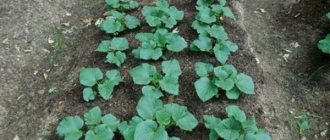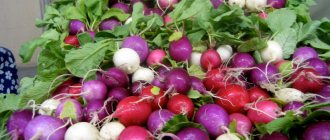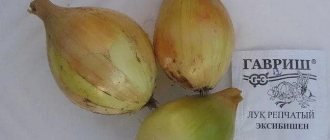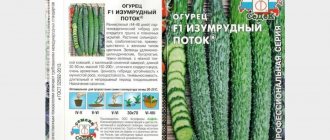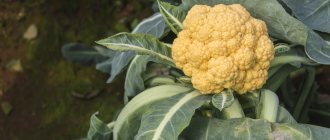Eggplant has long been one of the useful and favorite vegetables and is successfully grown in different regions of our country - under a film or in the open field. Among the many varieties, Roma F1 eggplant is especially popular, the description of the variety of which testifies to its excellent taste.
The early ripe hybrid F1 quickly won the recognition of gardeners with its high yield, versatility, and high commercial characteristics.
The best and most productive varieties of eggplants according to gardeners and experts
Traditionally, eggplants are predominantly a culture of the southern regions, which loves warmth and sun. Thanks to the work of breeders, new varieties and hybrids have been created that are truly unique. Now a healthy vegetable can be grown throughout the country, even in Siberia and the Urals. The seeds of modern plants are well prepared for harsh conditions and are not afraid of low temperatures. In this regard, hybrids are stronger than eggplant varieties, which require careful care.
To date, many varieties and hybrids have been created, some of which ripen earlier than others, others are leaders in yield, etc. There are many classifications. Below we will consider eggplant varieties according to climate, ripening period, and also present modern novelties. At the end, there are gardeners' reviews of the best varieties of eggplant.
The content of the article:
1. The most productive varieties of eggplant 1.1 Sancho Panza 1.2 Annette F1 1.3 Bibo F1 2. New original varieties of eggplant 2.1 Taste of mushrooms 2.2 Icicle 2.3 Pink flamingo 2.4 Emerald 3. Varieties of eggplant for open ground 3.1 Gribovsky 3.2 Spherical 3.3 Simferopol 4. Varieties of eggplant for growing in the greenhouse 4.1 Bagheera 4.2 Baikal F1 4.3 Fabina F1 5. The best varieties of eggplant for the Moscow region 5.1 Giselle F1 5.2 Agate F1 5.3 Albatross 5.4 Don Quixote 6. Early maturing varieties of eggplant 6.1 Nadir 6.2 Diamond 6.3 Negus 6.4 Czech early 7. The best varieties of eggplant for Siberia 7.1 Big lump F1 7.2 Nutcracker F1 7.4 Early maturing 148 7.5 Dwarf early 921 8. Black eggplant varieties 8.1 Black handsome 8.2 Black giant F1 8.3 Black prince 8.4 Black opal 9. Self-pollinated eggplants - popular varieties 9.1 Milda F1 Syngenta 9.2 Airship 9.3 Solomon 9.4 Torpedo 10. Ultra early hybrids 10.1 Tyrrenia F1 10.2 Anet F1 10.3 Fabina F1 10.4 Ultra early F1 11. Varieties eggplant for the middle lane 11.1 Lilac mist 11.2 King of the North 11.3 Long purple 11.4 Epic F1 12. Eggplant for growing in the Urals 12.1 Diamond 12.2 White night 12.3 King of the F1 market 12.4 Big Dump F1 13. Reviews of summer residents about the best varieties of eggplant they have grown
The most productive varieties of eggplant
For every grower, harvest is an important indicator and main motivation. The yield advantage among the eggplant crop lies with hybrids. However, there are a couple of varieties that perform well in this category.
The most productive eggplants! Choose varieties - video
Sancho Panza
The finest eggplant in this category. Ripens in medium terms. Sancho Panza is grown both through seedlings and through seeds. Suitable for both greenhouse conditions and for growing in the open field. Fruit weight is 0.7 kg. The shape is smooth, rounded in the form of a ball. Eggplant Sancho Panza can be classified as a round variety.
Despite this, it is enough to feed an average family of 4 people (yield - 7.5 kg per 1 m2). It makes especially tasty preparations for the winter. Even after heat treatment, the taste remains the same rich.
Photo of eggplant Sancho Panza
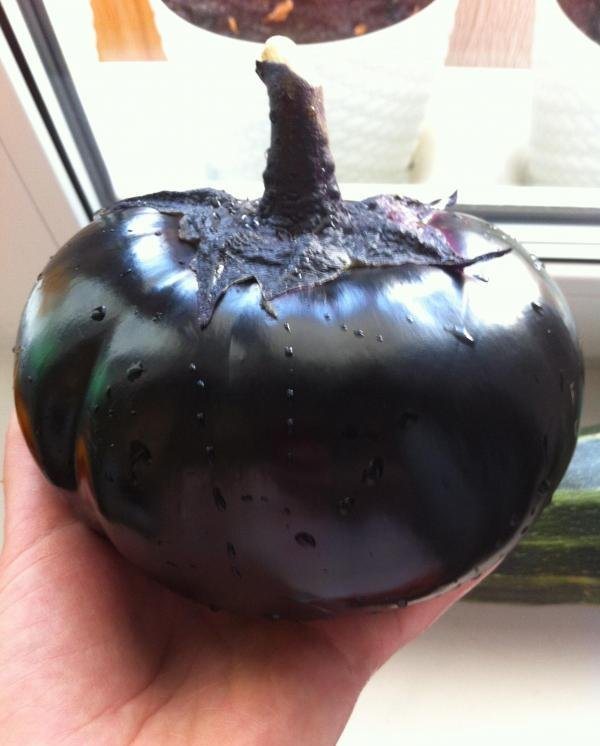
Eggplant Annette F1
A hybrid that has gained worldwide popularity in terms of quantitative and qualitative characteristics of yield. A distinctive feature is the constant formation of more and more new ovaries.
Thus, fruiting continues until frost. It ripens in medium terms, so it is not necessary to plant early in open soil. Has good immunity. Vegetable weight up to 0.4 kg. Classic eggplant color. In order for the Annette F1 hybrid to bear fruit well, you need to water the plants often.
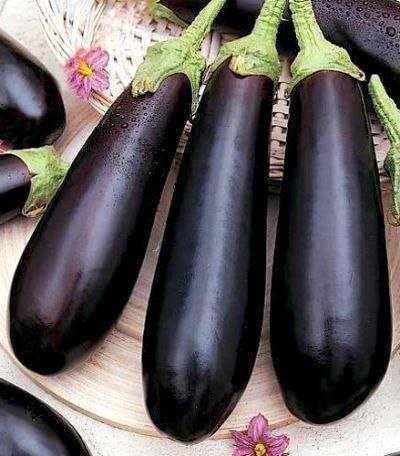

Bibo F1
Another hybrid. He has an oval-shaped fruit, unusual for a zucchini. And the color can be confusing. The vegetable is white, which completely distinguishes it from the rest of the "mass". Unlike the rest, it is small. Weight reaches only 230 grams, sometimes less. Bibo F1 eggplant is tied in bunches, which is the reason for the good yield (5 kg per 1 m2). The bushes grow up to 90 cm in height. Requires a garter to support. The flesh of the hybrid is very tender. There is no bitterness in the taste.
Eggplant Bibo F1 - photo


Harvest representatives of the eggplant culture are distinguished by large fruits that are great for canning, as well as preparing a wide variety of culinary recipes.
Watering
Watering should be regular and abundant. Be sure to water the soil after applying mineral fertilizers. The best liquid for irrigation is water that has been kept for several days. During this time, it will heat up and get rid of chlorine.
Watering frequency depends on weather conditions. Reduce watering on cold days. To retain moisture on hot days, the soil is mulched. Indicators of lack of moisture:
- drooping leaves;
- falling buds;
- ovary loss:
- yellowing of fruits.
Excess moisture also has a negative effect on fruits and plants. This is evidenced by stem decay and fruit spoilage.
New varieties of eggplant
Thanks to selection, other eggplant colors were obtained, except for white. There are yellow, red, and green vegetables, as well as with striped skin, which is quite a curiosity. Therefore, it is worth talking about the new eggplant varieties.
Mushroom taste
This is a Russian variety. The name was given because the vegetable has a real mushroom flavor, which most resembles champignons. There are no seeds in the pulp. It is aromatic and soft. In spite of this, The eggplant variety "Taste of Mushrooms" is perfectly stored without loss of taste. It can be transported over any distance.
The size of the vegetable is from 200 to 250 grams. The rind is milky. They are grown both in a greenhouse and in an open-air garden. Early ripe. Fruits appear on the 95th day after planting. Productivity - 6.5 kg per 1 m2.
![Tinkoff (Debit Card) [CPS] RU](https://bgn.imadeself.com/wp-content/uploads/tinkoff-debetovaya-karta-cps-ru10.jpg)
![Tinkoff (Debit Card) [CPS] RU](https://bgn.imadeself.com/wp-content/uploads/tinkoff-debetovaya-karta-cps-ru10.jpg)
Eggplant variety Icicle
The representative of the domestic selection. Ripens on the 110th day. For this reason, the Icicle variety is equally suitable for greenhouse conditions and for open ground beds. It is named so because of the elongated shape of the fruit, which looks like an icicle. The color of the eggplant "Icicle" is snow-white. Many who have grown this variety speak of an amazing taste that must be tried. Good for pickling and preserving.
Photo of eggplant Icicle
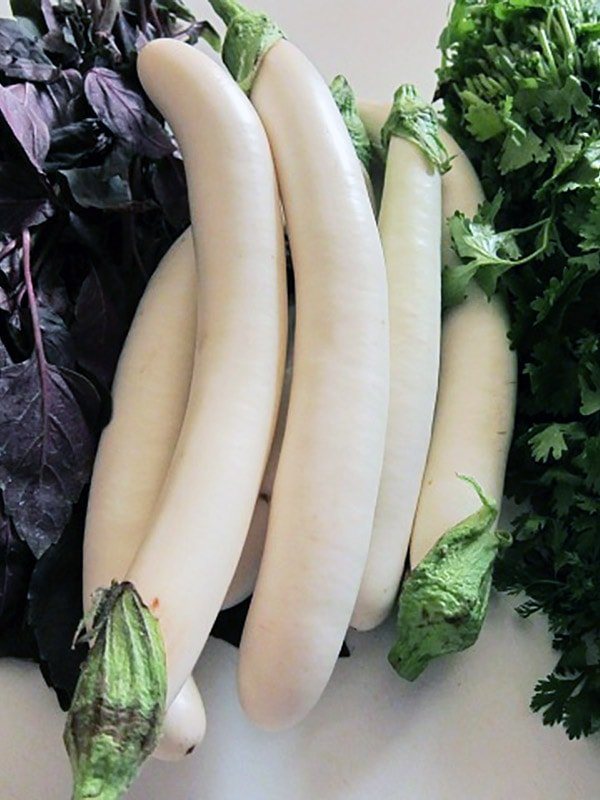

Pink flamingo
Another "curiosity" of the eggplant culture. "Pink Flamingo" ripens in medium terms and is included in the category of "tall varieties". The stem grows up to 1.80 m. The ovaries are formed in bunches, each of which contains from 3 to 5 vegetables. The indisputable advantage is exoticism.
The fruits are elongated and have a pink color with a violet hue. The inside is soft, white. There are no seeds. There is no bitterness in the Pink Flamingo eggplant. Weight - up to 0.4 kg. Productivity up to 7.6 kg per 1 m2.


Eggplant Emerald
No less unusual shade of the fruit has this variety of eggplant - emerald green. And it looks more like an overgrown cucumber than an eggplant. Ripens early. The bushes are compact, withstand cold temperatures.The fruits are elongated, in the form of a cylinder. The mass of one fruit reaches 450 grams. There is no bitterness in the white and tender pulp. It is also a high-yielding variety. Productivity up to 7.3 kg per 1 m2.


The exotic color is certainly pleasing to the eye. Delicious culinary dishes are prepared from them. Representatives of this group adapt well to new conditions.
From the history of the origin of eggplant
The homeland of the vegetable is Southeast Asia, to be more specific, tropical India and Burma. There the plant was observed to grow wild. It is believed that eggplant was attributed to cultivated plants in the first millennium BC.
The Greeks in ancient times were convinced that this vegetable can make a person crazy, in connection with which they called the eggplant "the apple of rage". Because of this, the plant came to European countries much later.
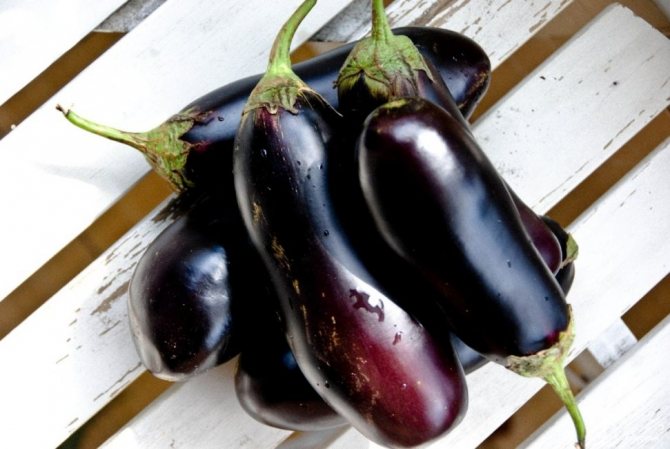

Initially, eggplants were used for decorative purposes, as the fruits of different shapes, colors, shiny
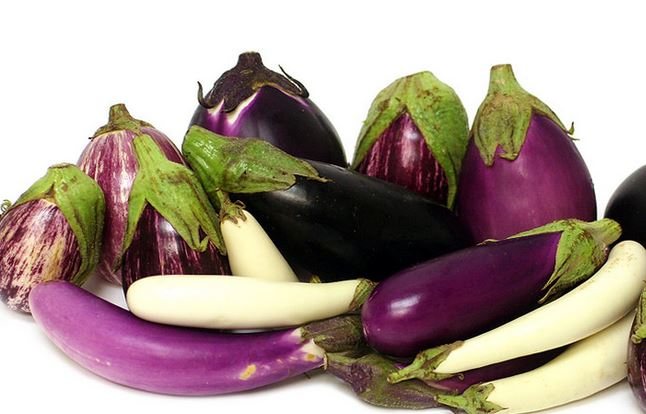

After the information received that the Indians eat vegetables, they began to be celebrated in South America. The Russians adopted the experience of eggplant cultivation from the Caucasians and the inhabitants of Central Asia, this happened in the 18th century. In the southern part of the country, varieties such as Odessa early and Bulgarian semi-long began to be grown.
The first subspecies was sown at the end of the second month of winter, and the second at the twentieth of February. Harvesting was carried out for the Odessa variety in late June, early July. For another, at the beginning of August.
Eggplant varieties for open ground
Eggplants, despite their love of warmth, can be grown outdoors and get a decent harvest. Special varieties of eggplant for open ground have been created. Vegetable growers argue that ultra-early varieties and with an average ripening period are most suitable for such conditions.
The best varieties of eggplant for open ground - video
Gribovsky
The Gribovsky eggplant variety is early maturing.
The Gribovskiy eggplant variety has excellent taste characteristics and snow-white pulp, in which there is no bitterness. Eggplant aroma is pronounced. Fruits appear on the 100th day after planting. The fruits are pear-shaped and purple in color. Bushes of medium height with thin branches. Due to the thinness of the branches, the crop must be harvested immediately after ripening.
Globular
Perhaps one of the most interesting varieties. It has massive rounded fruits. The weight of one fruit reaches 400 grams. The pulp is firm and dense. For this reason, it is imperative that heat treatment is required for eating. They work well as a filling. There is no bitterness in the "Spherical" variety. Perfectly transported over long distances.


Attention:
feature of eggplant "Spherical" in branching shoots, therefore, in order to form ovaries on them, it is required to carry out systematic pinching.
TOMATOES!
Tomato Katya F1Tomato Blagovest F1Pink Bush
Simferopol
Another popular medium-ripening eggplant variety for outdoor use. The first fruits can be tasted as early as 4 months after planting. The form is determined by the climate conditions of the area in which the culture grows. In any case, it is stretched out. The color of ripe fruits is lilac with a gloss on the peel, which becomes noticeable when exposed to the rays of the sun. Has a high yield.
To get a good harvest outdoors, you need to give preference to resistant species, as well as those that have large, spreading bushes.
... In this case, additional ovaries are formed on the sides, which increases the amount of the crop.
Red, orange, yellow
Eggplants of yellow, orange and purple color are almost impossible to find in our gardens. And yet, these types of eggplant exist.
The bright sunny fruits of yellow color and oval shape are given by the eggplant variety Golden Eggs presented in the photo, obtained by Dutch breeders.The eggplant pulp of this variety is rich in carotene, and the rest of the vegetable is similar to its more familiar garden relatives.
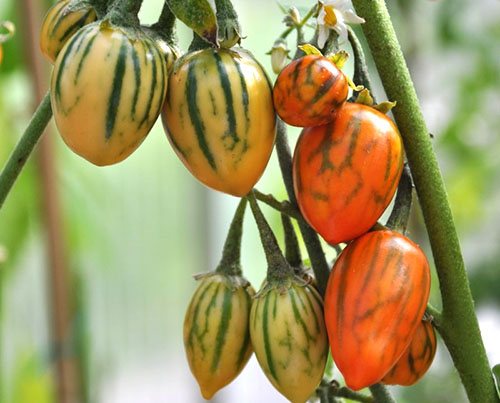

Being of African or Middle Eastern origin, Turkish eggplants are distinguished by their miniature size and the orange-striped color of the fruit that appears as it ripens. Young fruits of this type of eggplant are green, fragrant, without traces of bitterness, but gaining color, they begin to noticeably bitter. These thermophilic plants are popular in South America, where they came several centuries ago with slaves, and are valued for the lycopene contained in fruits, which is used to obtain anticancer drugs.
Red, more like miniature tomatoes or pumpkins, eggplants are grown both for small fruits and as an ornamental plant. The plant forms sprawling bushes. The leaves of this type of eggplant and the trunk, covered with sparse thorns, are often burgundy or purple in color. The fruits hold well on the stalks, on the cut they resemble jalapeno peppers, they are quite edible, but when ripe they can taste bitter.
The best varieties and hybrids of eggplant - video
The best varieties of eggplant
Eggplant varieties for the greenhouse
A guaranteed high yield can be obtained in a greenhouse. Super-early eggplant varieties are suitable here. There is absolute confidence in protection from pests and diseases, while observing the rules of care.
How to grow eggplants in a greenhouse - video
Bagheera
A compact variety that does not take up much space. A small greenhouse or greenhouse is ideal. Despite the compactness, the plants have a fairly dense foliage. Ripe fruits have an oval shape and a dark rich purple color. There is a gloss on the peel.
Photo of Bagheera eggplant
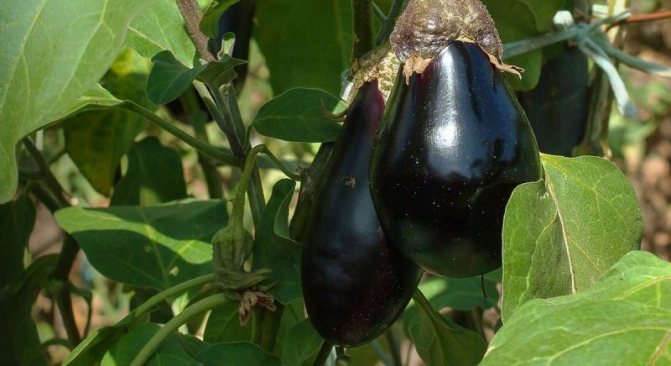

The pulp is tender, without a hint of bitterness. Fruits of the Bagheera variety can be stored and transported for a long time. Fruit weight - up to 330 grams. 12 kg of crop are harvested from 1 m2. It is advantageously resistant to diseases and pests.
Diseases and pests
Eggplant variety "BAGIRA" F1 is resistant to the most common diseases. Diseases develop extremely rarely, but if this happened, the plant must be dug up, the soil must be disinfected with copper sulfate or potassium permanganate, and the plant must be burned. Disease prevention is soil disinfection and seed treatment before planting.
Has the Colorado potato beetle attacked your eggplants?
Well no
The most dangerous pest of the "Bagheera" F1 variety is the Colorado potato beetle. In small areas, you can fight the beetle manually by collecting it and destroying the laid larvae on the leaves. If this did not help and the pests flooded the eggplant bushes, it is necessary to process the plant with chemicals or folk remedies (dusting with wood ash, spraying with wormwood infusion).
The best varieties of eggplant for the Moscow region
In the Moscow region, it is recommended to cultivate eggplants mainly in a greenhouse. This guarantees a good yield regardless of temperature extremes.
CHOOSE CUCUMBERS!
Cucumber Paratunka F1Cucumbers Granddaughter F1Cucumber Mother-in-law F1
Giselle F1
The hybrid is designed for outdoor and indoor use. Average height - up to 120 cm. Fruit weight ½ kg. The shape is elongated, in the form of a cylinder. The color of the peel is blue-purple eggplant, and the flesh is white. The taste is very delicate and juicy. Vegetables ripen in the 4th month after planting. Can be stored for a long time. A hybrid needs careful care to get a decent harvest.
In the open field, the yield of Giselle eggplants is 7 kg, and in the greenhouse it doubles to 14 kg.
Photo of hybrid eggplant Giselle F1


Eggplant hybrid Agate F1
A hybrid with dark purple fruits can grow in any territory, including the Moscow region. Undemanding to climatic conditions. Fruit weight - 230 gr. The shape is elongated. It is not afraid of frost, therefore it grows well in open ground.Productivity - from 8 kg per 1 m2 with systematic irrigation and fertilization.
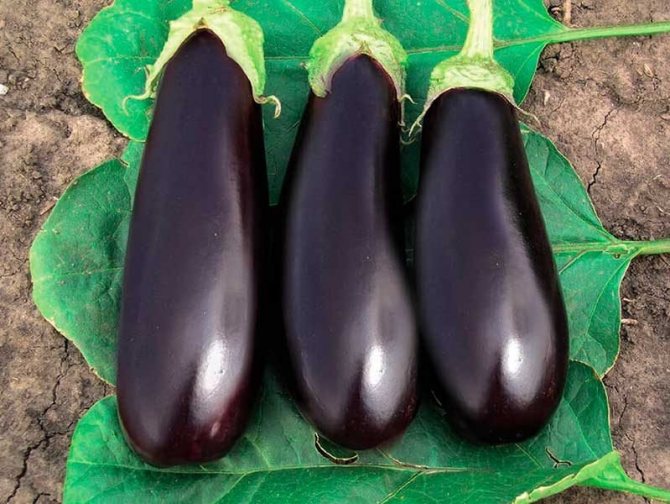

Albatross
A variety of medium ripening times. Pear-shaped, purple fruits form 120 days after planting in their permanent growth site. Eggplant bushes of the Albatross variety are spreading, with a large number of ovaries. They have a completely non-bitter green pulp. Weight - from 350 gr. The yield is constant - up to 9 kg per 1 m2. Resistant to mosaic disease (tobacco and cucumber species).


Don Quixote
Ripens early. Suitable only for growing in a greenhouse. The shape of the fruit is elongated and has a deep purple color. Inside, Don Quixote eggplant has a pale green flesh. Weight - from 250 to 300 gr. The length is 40 cm. The inside is without seeds and without bitterness. The pulp is dense, which allows the variety to be used for canning and other preparations. Productivity up to 9 kg from 1 m2.


What are the modern "blue"
Before buying eggplant seeds, you need to decide where they will be planted, for what purposes they will be used, and answer a few more important questions. In general, eggplant varieties are divided according to the following criteria:
- Ripening terms: early ripening, mid-ripening and late varieties. In addition to them, the early ripening subspecies is separately distinguished - these are vegetables that ripen in an extremely short time. The date of planting of seeds depends on the timing of ripening.
- Growing method: heated greenhouse, greenhouse, open ground.
- Productivity is the number of fruits harvested from one square meter of soil.
- Resistance - to diseases, temperature extremes, transplantation and other adverse conditions.
- Fruit type. This category includes the color of the eggplants, their size, weight, shape, taste.
- Type of bushes. For example, undersized, but branched varieties are more suitable for outdoor cultivation. They do not need to be tied up, they are not afraid of the wind, and quite a decent harvest can be harvested from the side branches. For greenhouses, you can buy seeds of tall varieties - they are very productive.
- Varieties or hybrids. Like all vegetable crops, eggplants are divided into varietal and hybrid ones.
Attention! Today there are hybrids of completely unimaginable shapes and shades: some cannot be distinguished from bananas, others exactly copy tomatoes. But all this is exotic. If the owner's goal is to get a high yield, it is better to buy seeds of proven varieties suitable for local latitudes (for example, "Almaz" or "Black Beauty").
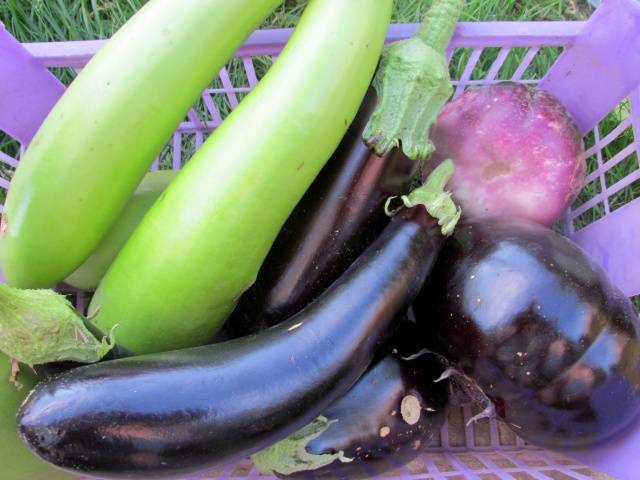

More recently, in Russia, they did not know about the existence of any other types of eggplants, except for the purple fruits of an oblong shape, which have a bitter taste. Modern varieties and hybrids are so diverse that it is almost impossible to choose the best varieties of eggplant. At least in each of the listed categories there are favorites, it is worth talking about them in more detail.
Early varieties of eggplant
Early maturing eggplant varieties are united, first of all, by the ripening period. Otherwise, they may differ:
be with bitterness and without, low and tall, have a different color, etc.
THE EARLY EGGPLANTS WE CHOOSE VARIETIES - video
Early variety of eggplant Nadir
The vegetable ripens within 2 - 2.5 months after planting. Grown by seedlings. Bushes half a meter high stand out with lush foliage. Ovaries are formed only at the bottom. Length about 15 cm. Eggplant weight - no more than 200 g. The color is bright purple. The peel is thin and glossy. There is no bitterness in the taste. You need to harvest Nadir on time to get more fruits.
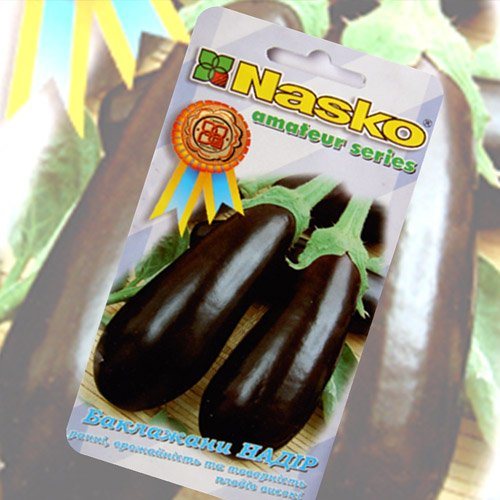

Early ripe eggplant Diamond
The Almaz variety can be classified as a popular eggplant variety. Cylinder-shaped fruits are formed after 75 - 80 days. The pulp is white. Bushes compactly fit on the site. Height up to 50 cm. The formation of ovaries occurs in bunches in the lower part, closer to the ground surface. The color is dark purple. Differs in excellent taste.
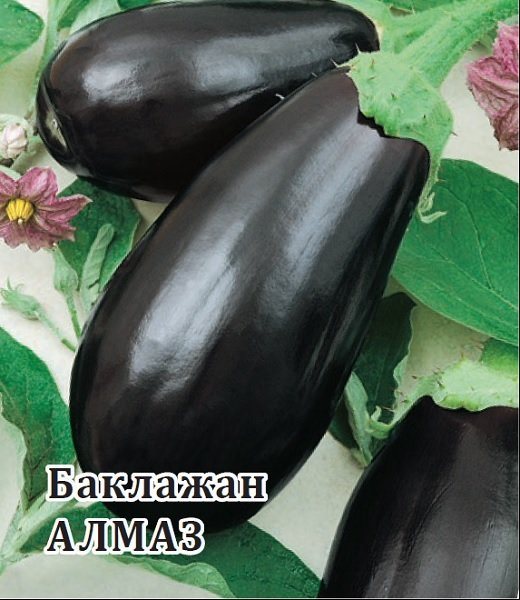

Negus
This is an ultra-early eggplant variety.Vegetables can be harvested within a month after planting. It has excellent taste characteristics. It grows up to 50 cm. Many shoots are formed on the sides. The shape is round. The weight of one copy is up to 180 grams. Medium density pulp. Harvesting is recommended immediately after ripening. Productivity of Negus eggplants is 7 kg per 1 m2.
Eggplant variety Negus - photo


Czech early
It is represented by compact bushes, no more than 60 cm high. The fruits look like a large egg weighing 0.6 kg. The color of the pulp is greenish-white without bitterness. The rind is dark purple. Grow Czech early through seedlings or seeds. Suitable for greenhouse and open field conditions. It is important to observe the distance between the landings, counting on 1 m2 to accommodate from 4 to 6 landings. Productivity - 5 kg.
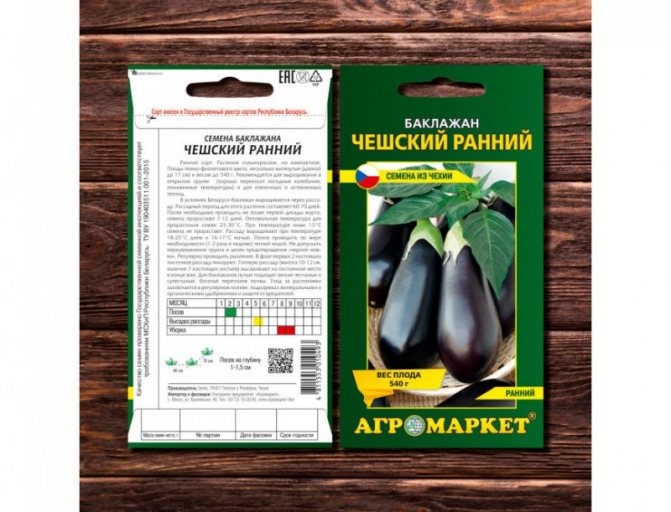

On a note!
Early ripening eggplant varieties produce a good harvest, as a rule, with proper care and timely collection of fruits. Suitable for canning and fresh consumption.
Useful properties of eggplant
The vegetable contains a lot of useful substances, especially for the heart.
- potassium
- calcium
- magnesium
- gland
- copper
- phosphorus
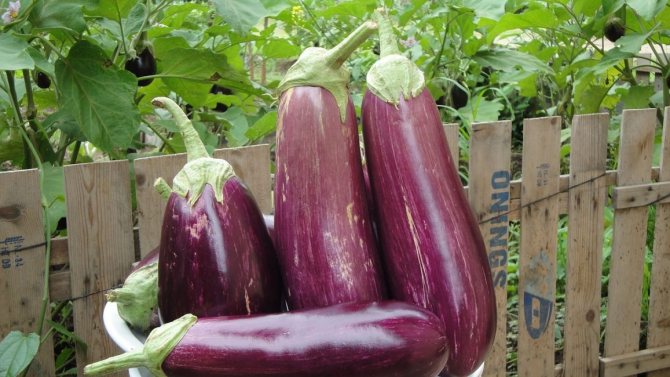

There are also vitamins B, C, PP, carotene
- atherosclerosis
- various heart diseases
- vascular pathologies
- obese
For prophylactic purposes to prevent colds, anemia, diseases associated with the nervous system, for elderly people to maintain the body in good shape. It is also advisable to include in a low-calorie diet.
- insomnia
- depression
- Bad mood
They need to be eaten after strokes, as the vegetable will help the body recover. Not prohibited for diabetics. Eggplant has regenerating, antibacterial properties. Eggplant infusion removes bile.
They say that if you regularly eat eggplant, it will help you quit smoking, since the vegetable contains nicotinic acid.
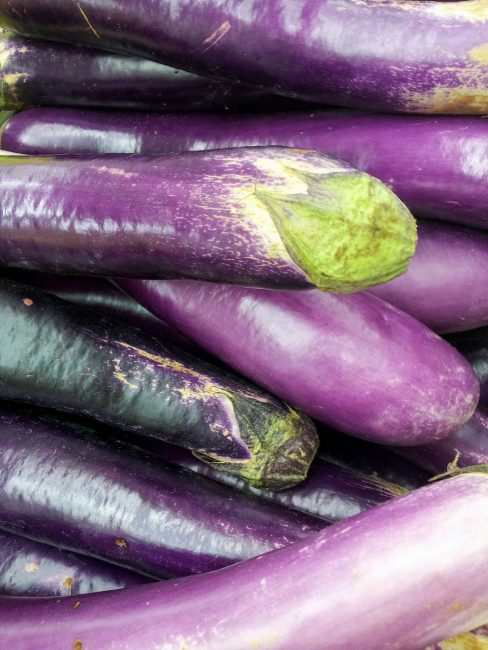

Dry peel can lower blood pressure
You need to grind it, eat a teaspoon before eating. This same powder will help strengthen your teeth and gums. For cooking, take salt and ground (to powder) eggplant peel in equal amounts (a teaspoon each) and pour in boiling water.
After cooling, rinse the mouth. To have a positive result and less harm to the digestive tract, vegetables should be consumed in a boiled form.
The best varieties of eggplant for Siberia
Eggplant varieties and hybrids in Siberian conditions must be resistant to low temperatures and frost. There are also such representatives among the culture.
Big lug F1
The bushes are low, up to 80 cm, but the fruits are relatively large. The weight can vary from 700 g to 1.5 kg. Designed specifically for harsh climates. The fruits ripen in the 5th month after planting the seeds. Sowing time in the beds is the beginning of summer. In July, they harvest, removing all the ovaries, leaving only the largest ones (6 - 7 pieces). Productivity - 7 kg per 1 m2.


Nutcracker F1
A variety of medium ripening. They are planted, observing the distance between plantings of 30 cm. The shoots are tall with long branches. The fruits appear constantly, which is an indisputable advantage of the Nutcracker eggplant hybrid. They appear at the top as well. The eggplant color is purple with a black tint. There is a gloss on the surface. Weight from 200 to 600 gr. Productivity 5 kg per 1 m2.
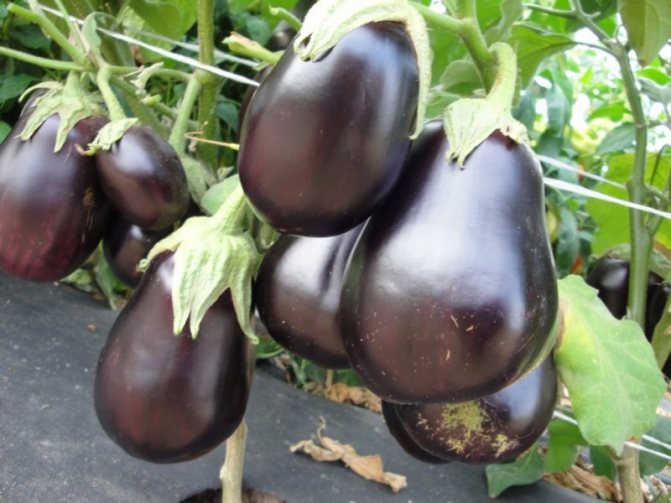

Precocious 148
Ripens on average, on the 120th day after planting. Doesn't require complicated maintenance. Bushes are low up to 50 cm in height. The most compact - 20 cm. On 1 m2 fit from 1 to 2 plants. Pear shape. Weight up to 200 gr. The color is blue-violet. The inside of the fruit has a white-green flesh. There is no bitterness. Low or medium yield - up to 5 kg.
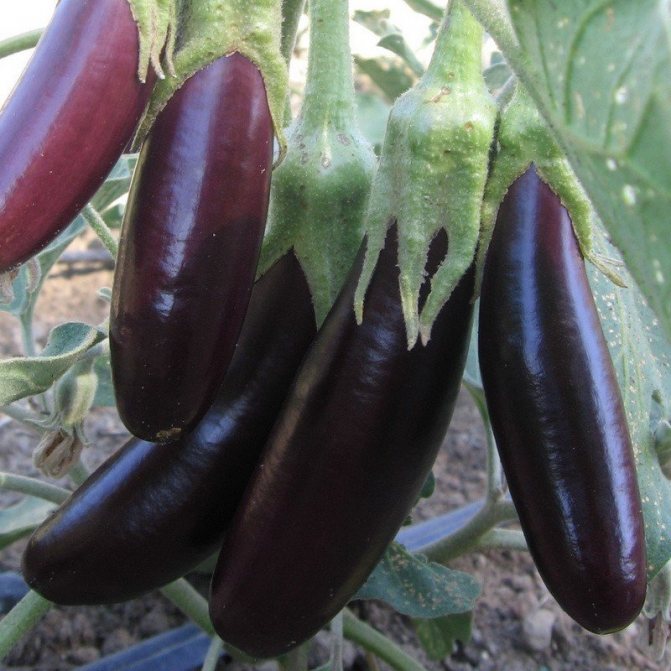

Early dwarf eggplant 921
The eggplant, which ripens quickly with many fruits, is notable for its low growth (up to 45 cm).Bears fruit in the 4th month. Weakly branching. The number of stems is not more than 5 per plant. The fruits are formed at the bottom. From leaving, it is only required to remove yellow leaves in a timely manner so that there is no obstacle to light. The fruits are round and slightly elongated. Weight up to 300 gr. Productivity - 6 kg per 1 m2.
Siberian eggplant varieties are easy to care for. In general, it can be noted that the yield is either high or medium. It depends on the variety.
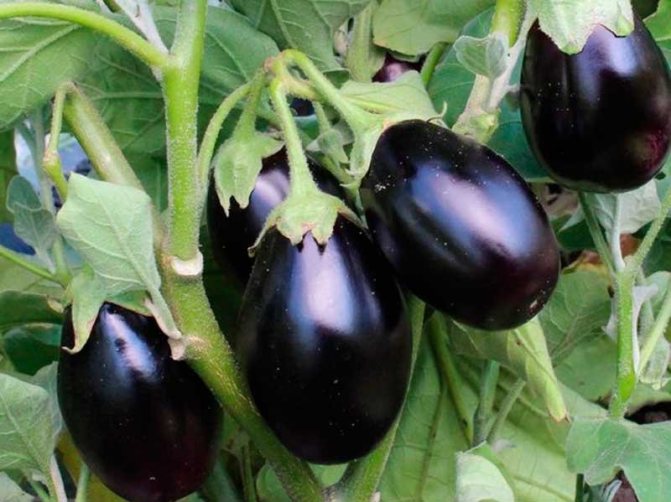

Growing features
Eggplant varieties Roma F1 grow well after predecessors such as carrots, onions, melons or legumes. Among the features of their cultivation are the following:
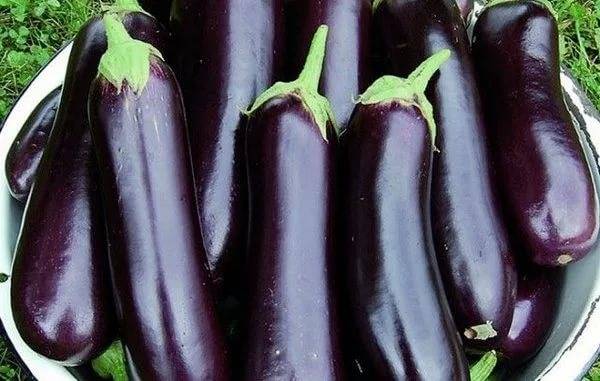

- thermophilicity - the growth and pollination of eggplants is inhibited at temperatures below +20 degrees; "Blue" very poorly tolerate frosts, which must be taken into account when transplanting seedlings;
- plants should be provided with sufficient moisture, otherwise the ovaries will begin to fall off, and the fruits will deform;
- the yield of Roma eggplants is highly dependent on soil fertility.
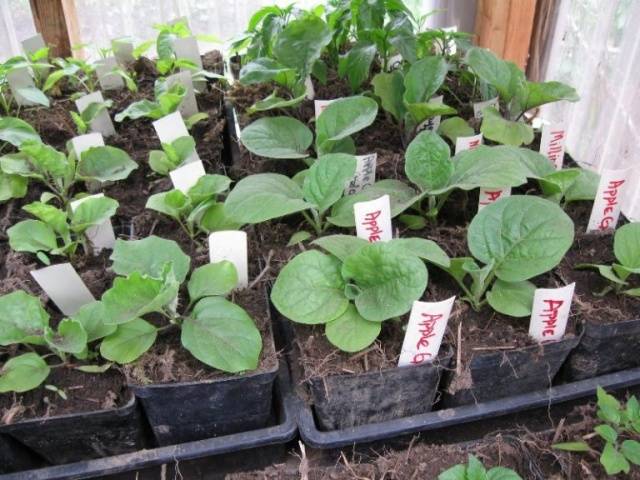

Roma eggplant beds should be prepared in the fall:
- dig up the selected area to the depth of the shovel bayonet;
- clear the land of weeds;
- at the same time add mineral fertilizers to the soil and mix well;
- in the spring, dig up the beds again, removing the remaining weeds and destroying the larvae of harmful insects in the soil.
Important! To retain moisture, it is better to carry out spring work after rain.
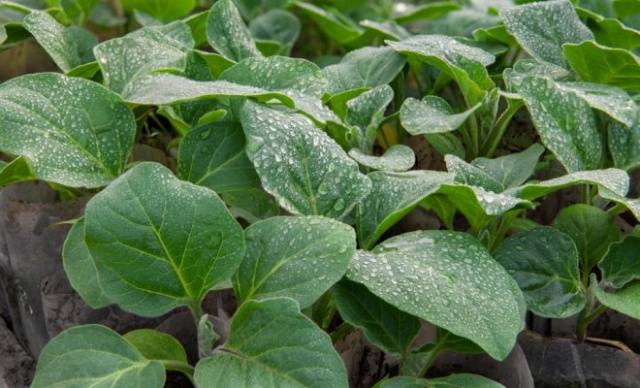

Black eggplant varieties
Separately, it should be said about the "black" representatives of culture. They attract vegetable growers with their color and taste. Careful care for them is sometimes required so that the fruits have all the characteristics inherent in the variety.
Eggplant Black handsome
It favorably differs in both good immunity and productivity. Large fruits look decorative. The shape is elliptical. Length up to 15 cm. The pulp is light creamy, without bitterness. The yield per 1 m2 is 12 kg. The vegetable is suitable for all types of culinary preparation.
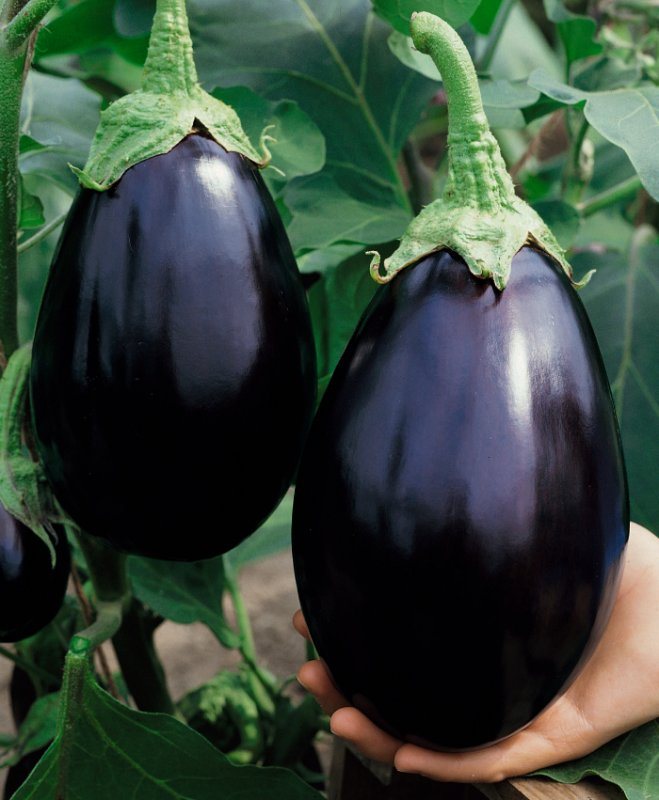

Eggplant Black Giant F1
An early ripening hybrid with a high yield.
The black giant bears fruit early, in the 2nd month after planting in the garden. The fruits are set constantly, so the harvest continues until the autumn period. Height - up to 1 m. Eggplant weight about 300 gr. The inside is dense white flesh.
It tolerates low temperatures.
Eggplant Black Giant F1 - harvest photo
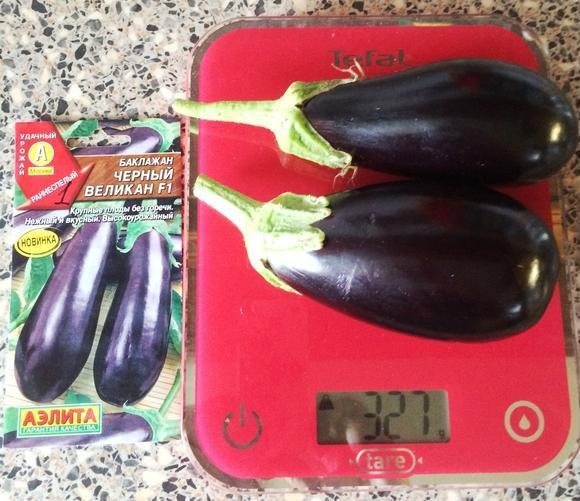

Black Prince
Favorably distinguished by early ripening and high yield (9 kg per 1 m2). The shape is slightly ribbed. The Black Prince belongs to the "Long Eggplant" group. The length is 25 cm and the weight is about 1 kg. Its peculiarity is a black and purple stem. There are seeds inside the fruit, and the flesh itself is pale yellow. Taste with a slight bitterness.
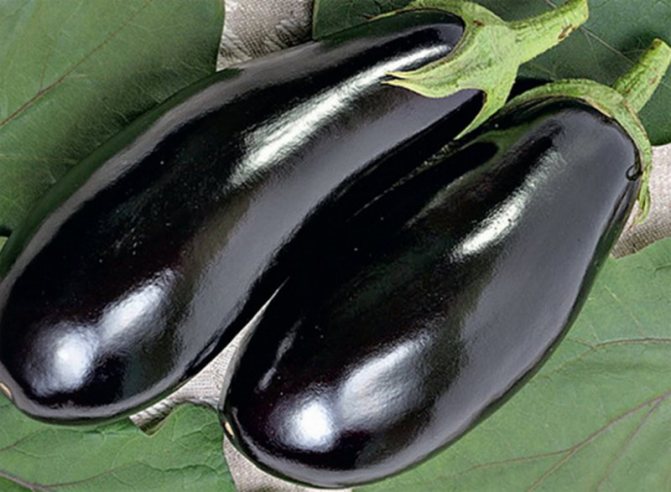

Black opal
A variety of medium ripening time. Fruits are cylindrical up to 18 cm in length. The peel is slightly rough, black-violet. Weight from 150 gr. The white pulp contains no bitterness. Adult eggplant Black opal grows up to 70 cm, spreading, so garters are needed. Average yield - from 5 to 7 kg per 1 m2.
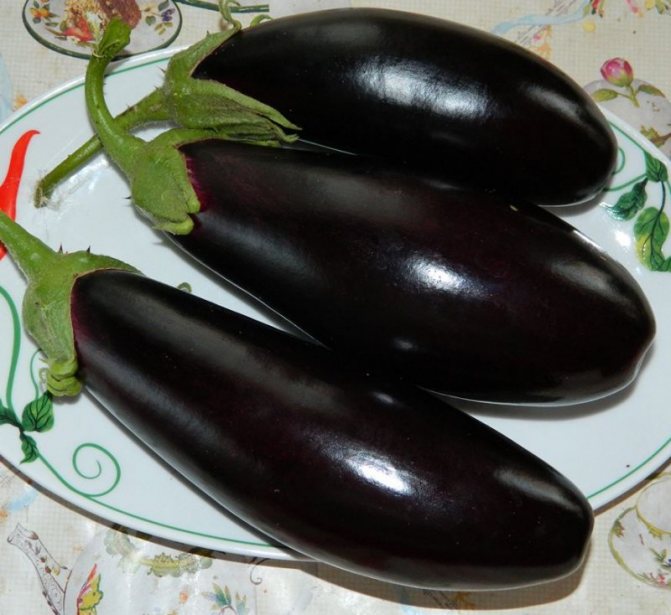

Care advice
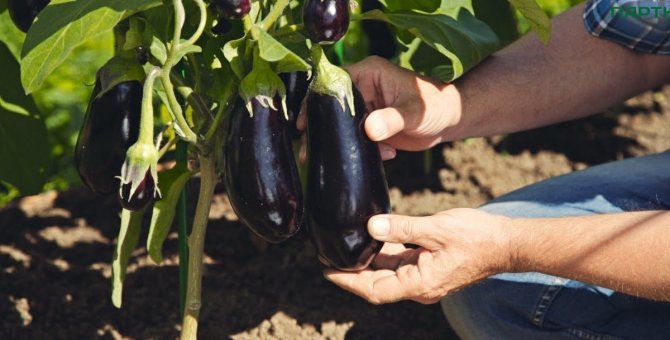

It is difficult to unequivocally answer the question of which manufacturer's seeds are the best. The main thing when choosing is to take into account those signs that are necessary for growing in a certain region:
- cold resistance;
- fruiting in conditions of changeable weather;
- high immunity;
- productivity and other important characteristics.
Many eggplants are grown everywhere, and the manufacturer gives a guarantee that they will have 100% germination. The acquisition of any type of culture will be successful if all the subtleties of care are observed during planting.
Some gardeners sow seeds already germinated, the selected seeds are placed in prepared individual pots. Before planting the selected material, the soil is watered with settled water. Deepen the germinated seeds by 2 centimeters. Sprinkle the seedlings on top with sifted earth.When planting, it is important to observe the temperature regime so that the sprouts rise on time. Place the seedlings in a draft-free place. During airing, ready-made sprouts are removed to another place.
Due to insufficient daylight hours, the sown seedlings are illuminated for the first time. The main task at this stage is to extend the daylight hours to 14 hours.
Also, caring for young shoots includes watering, which is carried out as the earthen coma dries. The dry soil is sprayed with a spray gun. 15 days after transplanting the sprouts, it is necessary to replenish them with liquid formulations.
For planting seedlings, make a deepening of 12 centimeters. Maintain a distance of 50 centimeters between the young. A small amount of ash is introduced into the wells, moistened with a weak solution of potassium permanganate. 15 days before planting, young animals are fertilized with a high-quality natural solution.
Young seedlings are carefully taken out without disturbing the earthen coma. Then they are placed in prepared wells.
Freshly planted seedlings are well watered after 3 days. The water used must be warm. To retain moisture, the trunk circle is mulched with dried straws, high-quality humus, sawdust. The blue ones have a developed system, thanks to which they perfectly withstand the sultry period.
Beautiful eggplants require significantly more life-giving moisture than aromatic peppers. After transplanting into open soil, the sprouts are watered for the first time after 5 days. Watering frequency depends on weather conditions. On cloudy days, moisture is sufficient after 7 days. During the period of heat and drought - after 5 days.
It is important to know that eggplant sprouts are watered directly under the root, the foliage should not get wet. You need to water it with exceptionally warm water, its temperature should be in the range of 25-28 degrees, at lower temperatures there is a risk of a decrease in flowering.
Top dressing
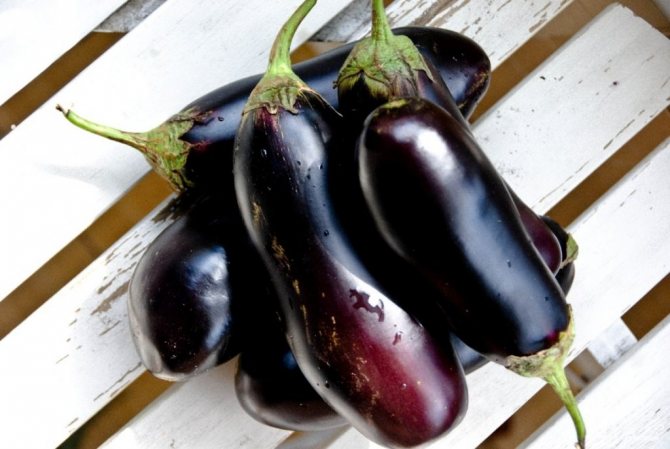

The first feeding is carried out 15 days after disembarkation of the young. The main thing is that during this time they have time to settle down and adapt. For this purpose, a complex composition is used. During bud formation, annuals need a balance of phosphorus and potassium. After the appearance of the first ovaries, the culture is fed with a nitrogen-phosphorus composition. Superphosphate and potassium salt are added a month before the desired harvest.
Loosening and weeding
Weeds attract harmful pests, plant diseases, so they should not be on the ridges with eggplants. Timely weeding of the beds will help prevent pest attacks. Loosening the soil is also required to provide life-giving oxygen to the roots. Loosening is enough to do once every 2 weeks.
Bush formation
It is necessary to form an eggplant bush due to the fragility of the shoots. Immediately after planting, the sprouts are attached to a small peg. It is not necessary to pinch the culture, the main thing is to remove yellow leaves and spoiled fruits in time. It is not necessary to remove the lower shoots that do not produce fruit, as they protect the soil from drying out.
For preventive purposes, the following recommendations are followed:
- do not allow strong temperature changes, excess moisture in the soil;
- carefully follow the order of crop rotation, do not plant eggplants in the same place;
- timely treat annuals with effective fungicides.
Eggplant viral diseases are treated with proven chemical compounds. They are saved from late blight by traditional means, for example, the Quadris drug.
Transplanting Roma f1 seedlings into open ground is carried out subject to certain rules in order to increase plant survival and effective fruiting.
In order for the plant to take root well in new conditions, it should be prepared by hardening. As a rule, hardening is carried out 2 weeks before planting of seedlings. They are gradually exposed to fresh air, with a regular increase in residence time.
Remember!
The main condition is the absence of frost at night.
Depending on climatic conditions, seedlings are transferred to the ground in the second half of May or the first half of June. The day before planting, abundant watering is carried out, as well as the second time just before planting.
It is important that the soil is fertilized and prepared from the fall. Also, a desirable condition is clearing the land from the emerging weeds in the soil. Landing holes are prepared in advance and must be abundantly flooded with water in advance.
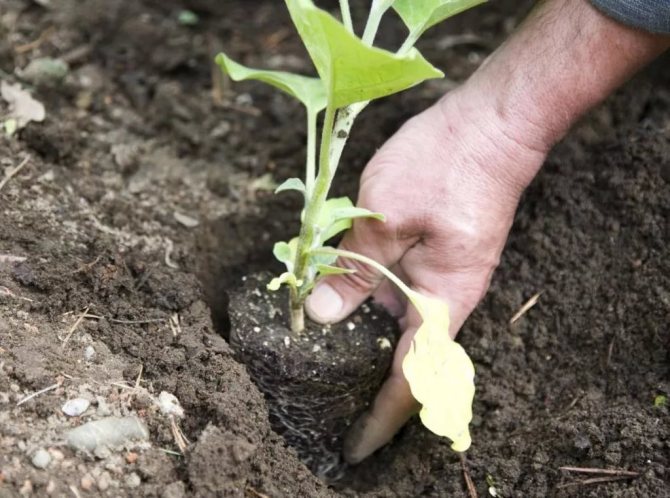

The transplant is carried out with soil around the root system.
The deepening into the soil during planting is 7-8 centimeters, depending on the size of the seedling. The root collar should be covered with soil by 1.5 cm. It is convenient to plant if the seedlings were grown in peat containers or plastic cups. It is efficiently planted according to the 40x50 cm scheme. The area with seedlings at night should be covered with a film that is placed on arcs. On warm sunny days, the film is removed. The soil under the bushes must be loosened.
For effective growth, it is important to adhere to the watering regime. It is important after the plant has been watered or it has rained to loosen the soil.
It is necessary to use water that has settled and warmed up under the influence of sunlight. Excessive soil moisture can lead to diseases and plant death. For the first time after planting, it is better to use the spraying method.
Advice!
Loosening the soil will provide oxygen access and evaporation of excess moisture.
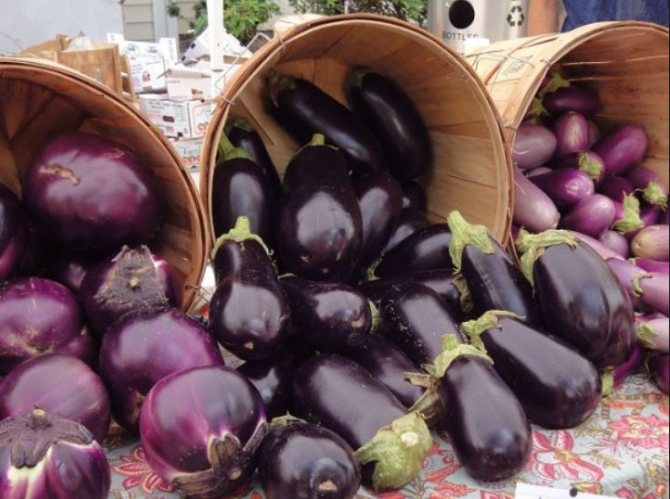

In cold weather, watering is carried out no more than 2 times a week, and in dry weather - 3 times. The soil should not be dry and crusty. If the eggplants are grown in greenhouse conditions, the amount of watering can be reduced. It is better to water in the evening or morning.
Fertilizers
For the intensity of growth and ripening of fruits, as well as in order to avoid the death of the plant, it is imperative to fertilize plants with various subcrustations.
Top dressing must be carried out in 3 stages: 2 weeks after planting in the ground, during the flowering period, during the ripening period. At the first stage, you can use manure or chicken droppings, always diluted with water. For the second stage, it is better to take specialized fertilizers that are sold in an agricultural store. Phosphorus and potassium should be added to the soil 1.5 months before harvesting.
Diseases and pests
This type of eggplant rarely suffers from disease. But with improper care, gray rot or late blight may occur. The only serious problem for this plant is the Colorado potato beetle, which can quickly destroy the plant. The fight against him should be started immediately. For these purposes, insecticides are used, as well as folk remedies and the collection and destruction of larvae and adults of the beetle directly.
There are many varieties with this characteristic.
Nancy F1
This vegetable crop has small, pale green leaves. The fruits weigh 80 g, and their shape is ovoid. The color of the eggplant is purple with a shiny surface. The pulp does not give bitterness and is presented in white. The Nancy variety perfectly resists the attacks of the spider mite. You can use the fruits for harvesting for the winter and as a whole.
Purple Miracle F1
The bushes grow up to 60 cm in height, the stem is mutely lowered, and there are green leaves with jagged edges on it. Ripe eggplants are cylindrical and glossy purple in color. The pulp is slightly greenish, there is no bitterness. The harvested crop has an excellent presentation and excellent taste. It is also resistant to spider mites and verticellosis wilt.
Purple Haze
The stem of the culture is strongly lowered, and its height is 60 cm. The leaves are of an ideal shape, smooth surface, there are no jags at the edges. you can harvest 100-105 days after sowing, they have an oval shape, a lilac skin. The pulp is white, not bitter. The variety resists bacterial rot.It is versatile in terms of cultivation, as it is suitable for various regions of Russia.
Bibo F1
When cultivating this variety, fruiting occurs on the 55th day after germination. The height of the bushes is 85 cm, as a result of which they need a garter. Bibo's vegetables are oval-conical in shape, and their length is 18 cm. The skin is milky white, and the flesh is white without bitterness. Eggplants of this variety are highly sought after among gardeners due to their excellent taste and dietary properties.
White egg
The bushes are compact in size, as the height reaches 70 cm. The vegetables are white, and their shape resembles an egg. One eggplant weighs 200 g, and its length is 10 cm. The variety is valued for its high yield and excellent taste. The pulp is tender and practically does not taste bitter.
I would like to note that with such an arrangement and number of fruits, as now, we must properly feed it and look after pests, prevent diseases, whitefly. Whitefly is very fond of eggplant. And, of course, diseases. Why do we go around these plants, holding a cigarette in our mouth, for example, so that there is no tobacco mosaic. Well, in principle, watering and fertilizing.
This fruit is still too small, but literally in 3-5 days it will be possible to cut it, it will be absolutely similar to this fruit in its size and quality. Now let's cut it open and see what it is from the inside.
Self-pollinated eggplants - popular varieties
Self-pollinated varieties and hybrids of eggplant are successfully grown in greenhouse conditions. They do not require pollination by other plants and insects.
The most popular varieties of eggplant -video
Mileda F1 Syngenta
Represents Dutch eggplant varieties. The hybrid is fully ripe on the 75th day after planting. The fruit resembles a cylinder. The pulp is creamy white. Firmly endures frost. The length of a ripe vegetable is up to 15 cm. The average weight is from 200 to 250 grams. The rind is deep purple. There is no bitterness in the taste. With high-quality care, a crop is obtained in an amount of up to 10 kg per 1 m2.
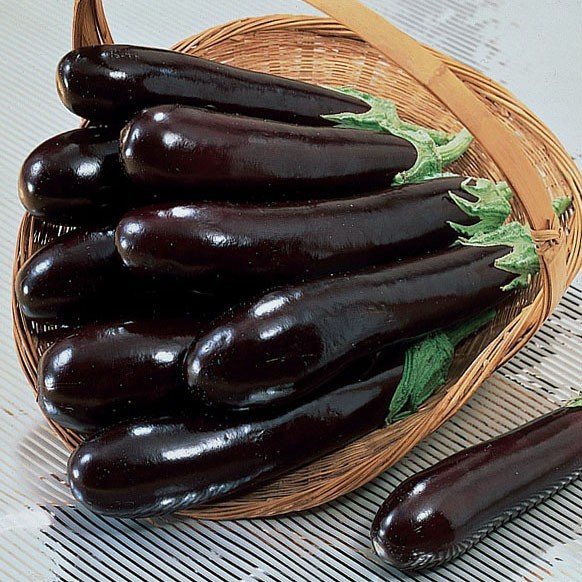

Airship
The beginning of fruiting of the Dirigible variety falls on the 125th - 130th day. The bush is well developed, fairly tall, with a lot of foliage. The maximum height is 4 meters when grown in a greenhouse. The shape of the fruit is elliptical. The mass is in the range from 700 to 1.2 kg per 1 m2. Productivity with careful care up to 10 kg. It has good immunity and keeping quality.
Eggplant Airship - photo
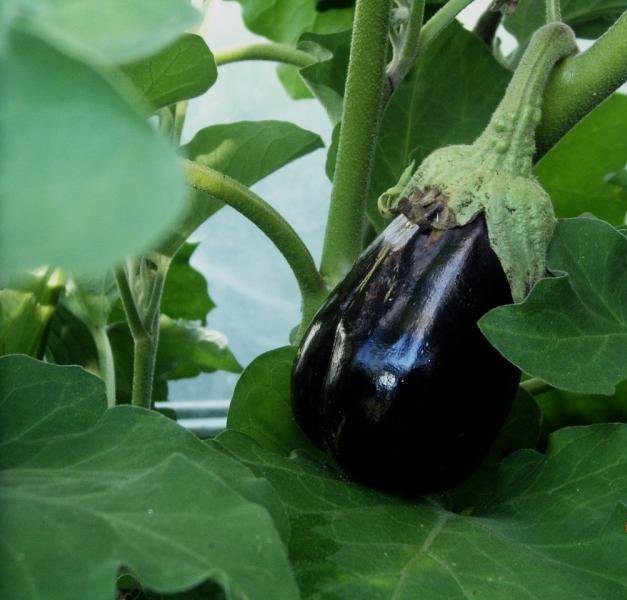

Solomon
Plants up to 150 cm tall. In greenhouse conditions, they can be higher than 2 meters. The fruits are massive. Garter required. The weight of one Solomon eggplant is up to 1.5 kg. They are distinguished by excellent taste. Fruiting occurs in 3.5 - 4 months. The color is rich purple, with gloss. The pulp is firm. The yield is high - up to 16 kg per 1 m2.


Self-pollinated variety Torpedo
A variety known for its yield. Dark purple, almost black fruits have a mass of 200 grams. Formed on the 120th day. The height of the torpedo eggplant bush reaches 170 cm, in greenhouses - up to 2.5 m. The surface of the fruit is flat and has the shape of a cylinder. There are a small amount of seeds inside. The pulp is tender, green.
Good to know!
Self-pollinated varieties and hybrids are preferred by greenhouses and hotbeds.
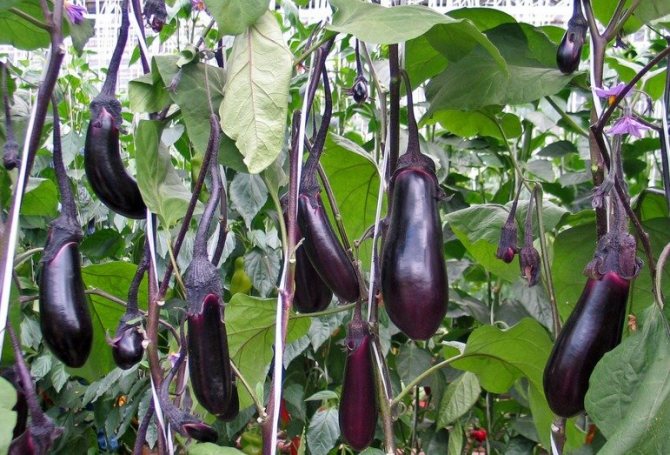

Growing seedlings
Eggplant Roma F1 loves open light areas with fertile soil, grows well on loam and sandy loam. The most convenient way is to grow through seedlings. Seeds are planted by the end of February or in the first decade of March.


Sowing seeds
The seeds of the hybrid variety Roma F1 do not require presoaking. They are planted in soil prepared from garden soil and humus, taken, in approximately equal parts, with the addition of a small amount of sand. If the seeds are pre-germinated, then the soil should be warmed up to +25 degrees before planting. Eggplant seeds are planted to a depth of 1.5 cm and covered with foil. It will speed up seed germination.The room should be kept at a temperature of 23-26 degrees.
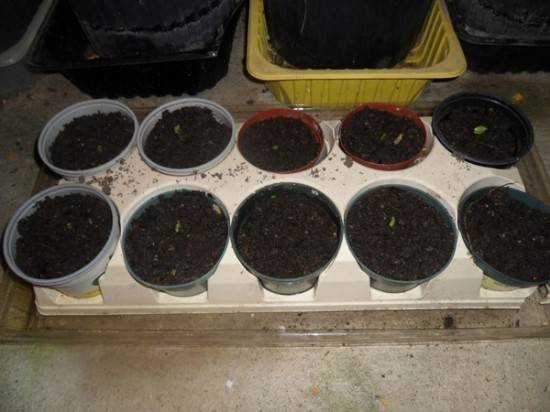

After 15 days, after the first shoots appear, the film is removed, and the crops are transferred to a well-lit place. At this time, it is advisable to reduce the temperature in the room to + 17-18 degrees in order to ensure the development of the root system. After a week, you can again increase the daytime temperature to +25 degrees, and at night it can be kept at about +14. This contrasting temperature mimics natural conditions and helps harden the seedlings.
Eggplant seedlings Roma F1 dive after the appearance of cotyledon leaves. Delicate sprouts are transferred carefully, with a lump of earth, trying not to damage the roots.
Important! Eggplant does not tolerate diving well, so experienced vegetable growers advise to immediately plant seeds in separate peat pots.
Ultra early hybrids
Separately, it should be said about eggplant hybrids ripening in record time. They are unpretentious in care, adapt well to any conditions. They give a good harvest.
Tirrenia F1
An early ripe hybrid with long fruiting. Eggplants appear before frost. Fruit weight 450 - 700 gr. There are almost no seeds. There is a tendency towards self-pollination.
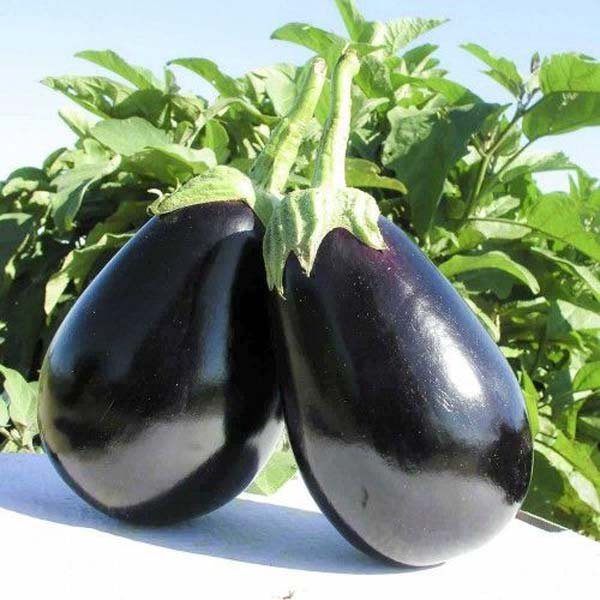

Anet F1
The eggplants are elongated, oblong. They look like a top hat. Weight - from 300 to 400 gr. The mature plant is strong, strong, with luxurious foliage. Fast recovery of leaf mass is characteristic, due to which pest attacks are not dangerous.
Photo of hybrid eggplant Anet F1
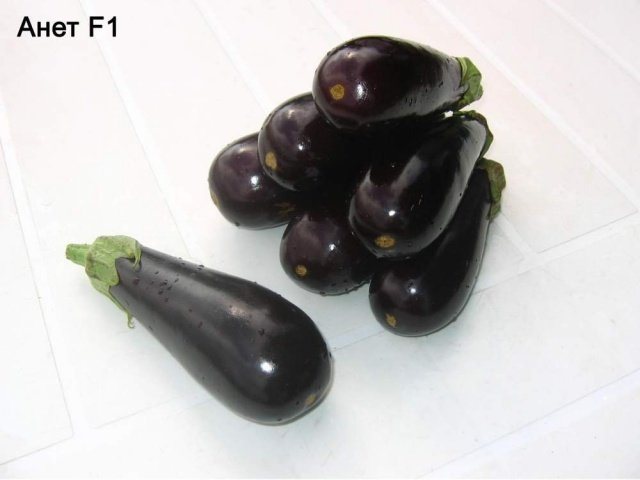

Fabina F1
A hybrid designed for both outdoor and indoor use. It ripens on the 70th day. On the bush, there are from 6 to 8 fruits of a dark purple color. At the time of technical ripeness, the peel of Fabina's eggplant hybrid is shiny. The pulp is white-green. There is no bitterness. Differs in good immunity.
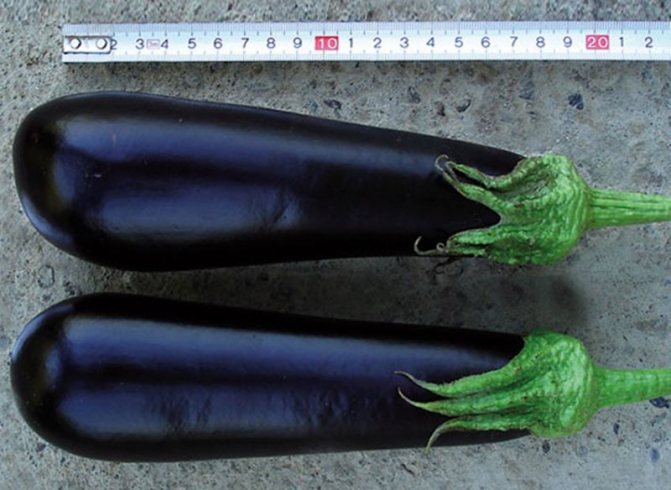

Eggplant Ultra early F1
Received in Ukraine. Fruits in the shape of a pear of a bright purple color weigh from 120 to 140 grams. Drought and disease resistant.
The pulp is tender, white-yellow. There is no bitterness taste. An adult plant branches well. Up to 15 fruits appear on one bush.
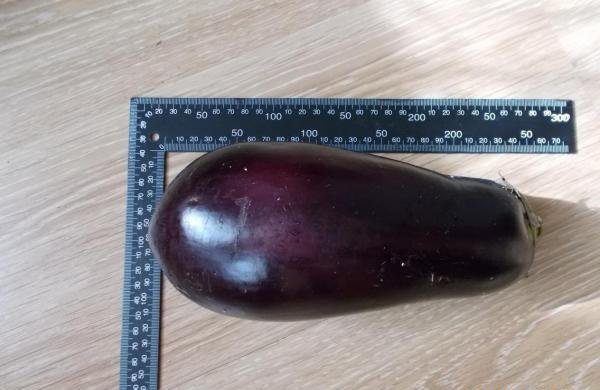

Ultra-early eggplants are a great choice for growers looking to harvest as early as possible. They are also suitable for beginners, as they are easy to care for and are not susceptible to diseases.
Pros and cons of the variety
This subspecies has pronounced advantages, thanks to which many gardeners choose it:
- compact bushes;
- perfectly tolerates transportation;
- long-term storage;
- early maturity;
- excellent taste, without bitter aftertaste;
- increased resistance to disease and drought.
During cultivation, the following shortcomings of the variety are noticed:
- thermophilicity, does not tolerate temperature drops, needs shelter;
- susceptible to attacks of various pests;
- requires the care and attention of the gardener.
Eggplant varieties for the middle lane
There are separate varieties and hybrids for the middle zone of the country. They are resistant to temperature extremes, excellent immunity and are easy to clean.
The earliest eggplants Choosing varieties for the Middle Lane - video
Purple Haze
An early variety that ripens 95 days after sowing the seeds. The bush is compact, up to 70 cm. The peel is either light purple or just purple. The fruit is cylindrical. Length - 18 cm. The snow-white pulp is juicy and tender, without bitterness.
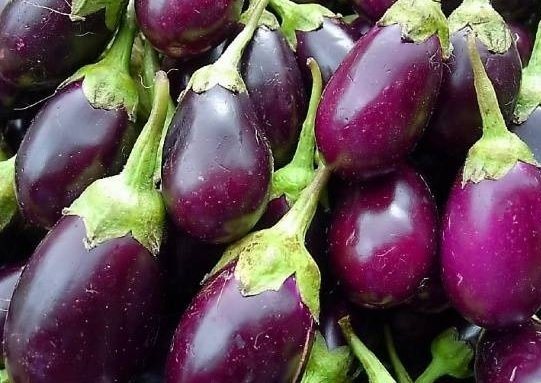

Eggplant King of the North
One of the most hardy eggplant varieties. In addition to the middle zone of the country, the King of the North is an excellent eggplant variety for the north-west. It brings a good harvest (up to 15 kg per 1 m2), which is due to the constant creation of new ovaries. Fruiting occurs on the 100th day. Eggplants up to 35 cm in length, have the shape of a cylinder. The rind is thin and the flesh is tender and juicy.
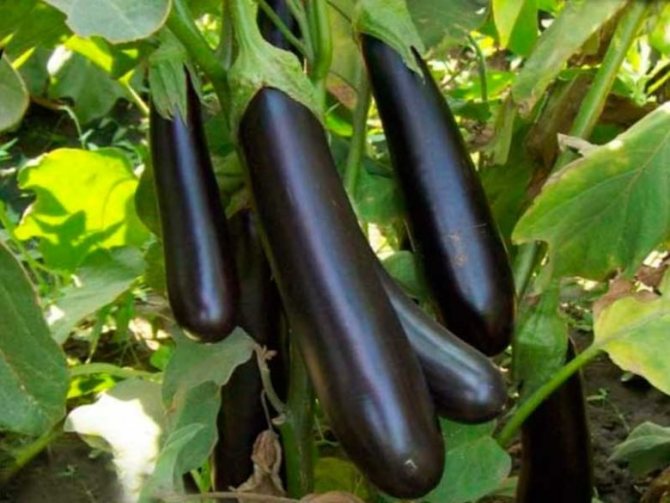

Long purple
Ripens on the 95th day. Fits compactly in the garden area. It can grow well both in the greenhouse and in the open field. The length of the fruit can be different:
from 12 to 24 cm. Weight is also different: from 100 to 300 gr.Productivity up to 9 kg from 1 m2.


Epic F1
A fast ripening hybrid that begins to bear fruit in the 2nd month. The fruits are in the form of a drop. The rind is black and purple. In length - up to 21 cm. Weight - up to 230 gr. The taste is "classic" eggplant. In open field conditions, with proper care, the yield of the Epic F1 eggplant variety is at least 6 kg per 1 m2.
Eggplant Epic F1 - photo


All varieties and hybrids of eggplant for the middle lane are suitable for preparing blanks for the winter. Many are well stored and transported over various distances.
Professional advice
Choosing the right crop variety is half the battle. When working with eggplants, you should know the intricacies of plant care. By listening to the recommendations of experienced gardeners, you can achieve a rich harvest.
- In the greenhouse, seedlings are planted after the twenties of May. The soil is pre-moistened. For species that give small plants, 40 cm between them is enough; for lush bushes, the figure increases to half a meter.
- In the open field, eggplants are not in danger after the onset of real warm weather. Suitable seedlings up to 10 cm in height and with 6-7 true leaves.
- During the first decade, watering is not performed. This technique is designed to protect fragile roots.
- After the first watering, the plant is fed with an organic fertilizer solution. The procedure is repeated after 20 days and at the beginning of the appearance of fruits. In these cases, nutrition is supplemented with mineral compositions.
- Watering is carried out with warm water to the root area. To reduce air humidity in a closed greenhouse, it is necessary to ventilate.
- Loosening the eggplant beds has a positive effect on the yield.
From the whole variety of varieties, you can choose the right type for your region. This will make it possible to grow a good harvest and please loved ones with your favorite dishes. The main thing is to provide proper care for plants at all stages of growth and maturation.
Varieties and types of eggplant for your beds
25 october 2015


The list of species and varieties of garden plants in the beds of summer cottages and household farms is expanding every year. If not long ago a rare gardener decided to grow eggplants, today this and many other crops are quite common and give good yields in various parts of the country. Cultivating tomatoes, cucumbers, sweet peppers. plant a few bushes of the eggplant variety you like in the garden to please your family with delicious dishes.
When the basics of agricultural technology are mastered and the first purple fruits are harvested, it's time to choose varieties and types of eggplants for planting next season. And there really is something to see, especially since thanks to breeders from all over the world, eggplants have long ceased to be only "blue". Now in the beds among the bushes with traditionally purple fruits, you can see white, green, variegated, and almost pink eggplants.
There are plants that produce yellow, orange and even red fruits, which outwardly differ little from sweet peppers or tomatoes, but inside they remain real eggplants.


In addition, today you can choose eggplant varieties and their hybrids:
- forming tall or compact plants;
- giving the usual cylindrical or surprising round, ovoid and long serpentine fruits;
- striking in yield and size of individual fruits, up to 2 kg in weight;
- different ripening periods;
- for growing in greenhouses, greenhouses or in the open field;
- resistant to diseases and unpretentious to growing conditions in the middle lane.
The choice of varieties and types of eggplant is so great that it is no wonder it is easy to get confused. If experienced summer residents know how to handle many varieties of plants in the beds, then for beginner gardeners it is more reasonable, having familiarized themselves with the characteristics of all kinds of eggplants in advance, to choose a couple or three early-ripening varieties in order to guarantee themselves tasty and healthy vegetables.
Eggplants for growing in the Urals
In addition to the "northern" varieties, there are also "Ural" varieties. Despite the thermophilicity of the culture, you can get a high-quality harvest here too.
Diamond
The variety is characterized by a low growth of bushes (no more than 55 cm). Eggplant Almaz feels great in different conditions: in a greenhouse, in a greenhouse, and in a garden bed. Fruits appear after 110 days.The length of an adult eggplant is 17 cm, and the weight is 150 - 160 g. They are distinguished by excellent taste. Sweetness is present. The flesh is green, quite dense. Productivity - up to 7.5 kg per 1 m2.
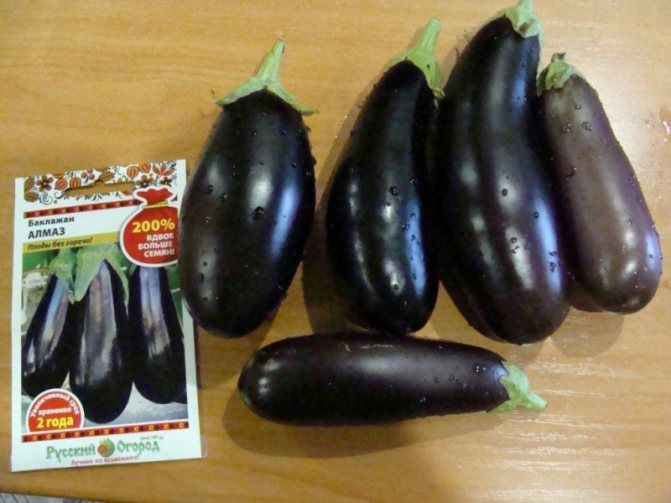

White Night
An early variety of unusual white color is compactly placed at the planting site. The shape of the fruit is slightly curved and looks like a cylinder. The height of the bushes is no more than 50 cm. But the yield is high (up to 6 kg per 1 m2). The taste is soft, without the presence of bitterness. The rind is thin, smooth.


King of the F1 market
Has a lot in common with the King of the North hybrid. For a good harvest, you need to plant seeds for seedlings in February or early March. This is a medium-ripening variety. It is often grown commercially for sale. The fruits are attractive and can be stored for a long time. Inside, the snow-white pulp is sweet in taste. Suitable for canning.
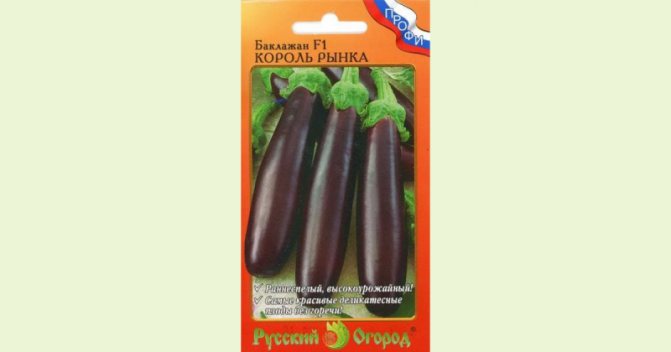

Pros and cons of eggplant
The advantages of the variety include:
- good fruit growth in cool summer;
- unpretentious cultivation;
- high taste;
- great productivity;
- tender pulp without bitterness and streaks;
- disease resistance of the variety.
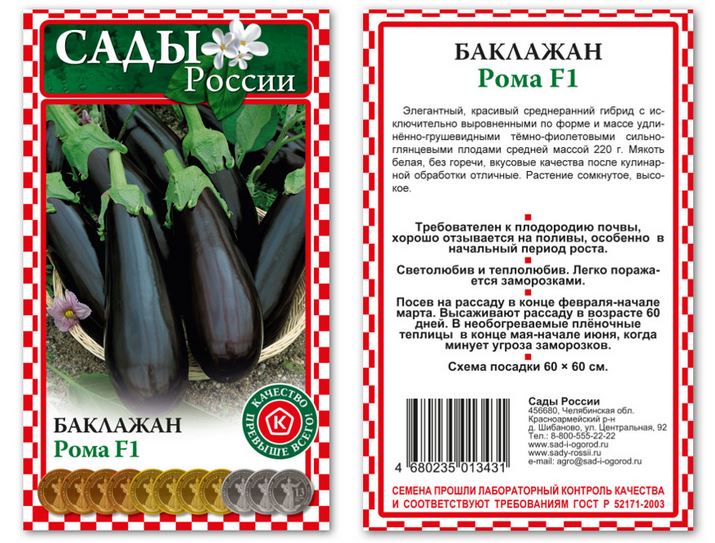

Many summer residents are accustomed to independently harvesting seeds from their favorite varieties of vegetables. Roma f1 belongs to hybrids and is not suitable for propagation with its own seeds. This is the only drawback that gardeners distinguish from fruits.




